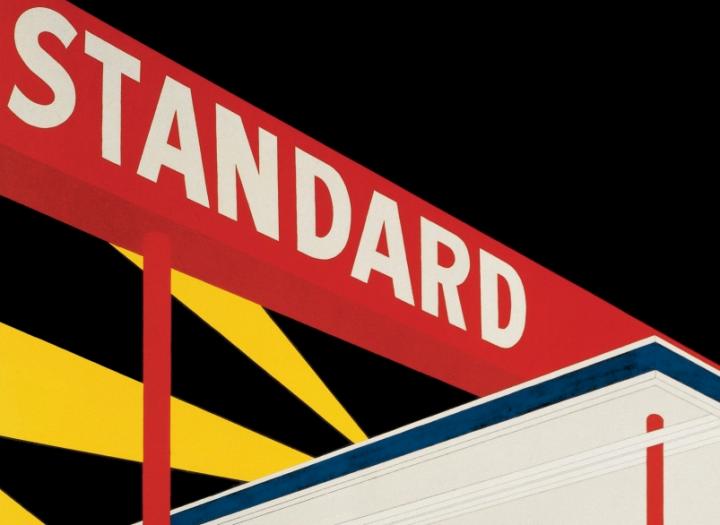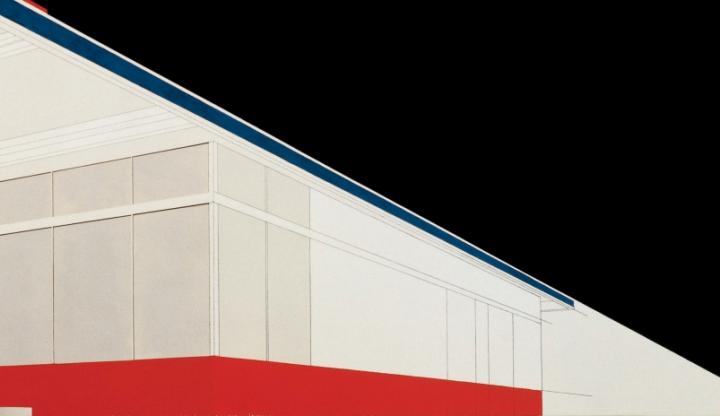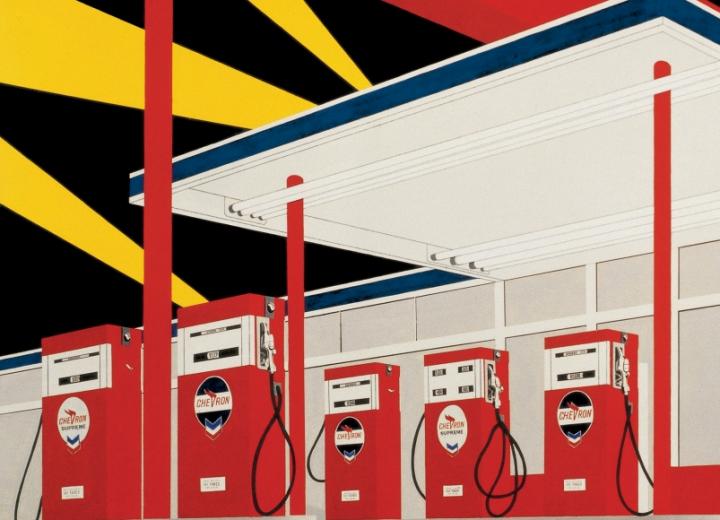
Edward Joseph Ruscha, Standard Station, Amarillo, Texas, 1963, oil on canvas. Gift of James Meeker, Class of 1958, in memory of Lee English, Class of 1958, scholar, poet, athlete and friend to all; P.976.281. © Ed Ruscha
Based on the Learning to Look method created by the Hood Museum of Art. This discussion-based approach will introduce you and your students to the five steps involved in exploring a work of art: careful observation, analysis, research, interpretation, and critique.
HOW TO USE THIS RESOURCE
1. Print out this document for yourself.
2. Read through it carefully as you look at the image of the work of art.
3. When you are ready to engage your class, project the image of the work of art on a screen in your classroom.
4. Use the questions provided below to lead the discussion.
Step 1. Close Observation
Ask students to look carefully and describe everything they see. Start with broad, open-ended questions like:
* What do you see?
* What else do you see?

Become more and more specific as you guide your students’ eyes around the work with questions like these:
* What do you notice about the composition (the way the objects are arranged in this painting)?
* Name the shapes. Describe the lines.
* What colors did the artist use?

* What do you notice about the gas station?
- the sign?
- the sky?

* How would you describe the artist’s style?
Step 2. Preliminary Analysis
Once you have listed everything you can see about the object, begin asking simple analytic questions that will deepen your students' understanding of the work.

For instance:
* In what country do you think this gas station is located? Why?
* What time period do you think this is?
* What time of day is it?
* Why do you think there are no people in this painting?
* Where would you need to be in order to see this scene from this point of view?
* What effect do all of the diagonal lines have on how you see this painting? How would it be different if you saw this gas station straight on and it was made up of horizontal and vertical lines instead?
* What type of artwork does this image remind you of?
After each response, always ask, “How do you know?” or “How can you tell?” so that students will look to the work for visual evidence to support their theories.
Step 3. Research
At the end of this document, you will find some background information on this object. Read it or paraphrase it for your students.
Step 4. Interpretation
Interpretation involves bringing your close observation, preliminary analyses, and any additional information you have gathered about an art object together to try to understand what a work of art means. There are often no absolute right or wrong answers when interpreting a work of art. There are simply more thoughtful and better informed ones. Challenging your students to defend their interpretations based upon their visual analysis and their research is most important.
Some basic interpretation questions for this object might be:
* What do you think this artist was trying to express about gas stations in America in 1963?
* How does this painting call to mind the culture of the 1950s and 1960s?
* What does this image make you think about gas stations in America today?
Step 5. Critical Assessment and Response
Critical assessment and response involves a judgment about the success of a work of art. This step optional but should always follow the first four steps of the Learning to Look method. Art critics often engage in this further analysis and support their opinions based on careful study of and research about the work of art.
Critical assessment involves questions of value. For instance:
* Do you think this painting is successful and well done? Why or why not?
This fifth stage can also encompass one’s response to a work of art. One’s response can be much more personal and subjective than one’s assessment.
* Do you like this painting? Does it move you?
* Do you think it is still relevant today?
Background Information
Edward Joseph Ruscha, American, born 1937
Standard Station, Amarillo, Texas, 1963
Oil on canvas
Gift of James Meeker, Class of 1958, in memory of Lee English, Class of 1958, scholar, poet, athlete and friend to all; P.976.281.
During the late 1950s and 1960s, Los Angeles artist Edward Ruscha repeatedly drove along U.S. Route 66 to visit his family in Oklahoma City. These trips inspired a series of photographs, Twenty Six Gasoline Stations, and this painting of the Standard Station in Amarillo, Texas. Searchlights scan the night sky, beckoning travelers everywhere to this red-white-and-blue icon of American life, a pristine structure bathed in fluorescent light. As the artist explained, "I don't have any Seine River like Monet. I just have U.S. 66 between Oklahoma and Los Angeles."
Standard Station, Amarillo, Texas helped to define both the modern American landscape and the artistic movement that engaged it in the 1960s and beyond: Pop Art. The attention to detail found in the precise lines, angles, and lettering (a reference to Ruscha's interest in commercial art) contrasts with the lack of true representation in the scene. The painting appears simultaneously realistic and contrived. Its subject does not look like a gas station at all—the lack of people, cars, or signs of wear and tear makes the structure seem too crisp and shiny to be a working station. It instead could be viewed as a gesture of admiration for the newness of car culture. Furthermore, it now seems a prophetic statement about American dependence on oil. The painting also has the format of a European Renaissance altarpiece, with the pumps standing in for saints and the beam of light sanctifying the lowly gasoline station as a secular icon.